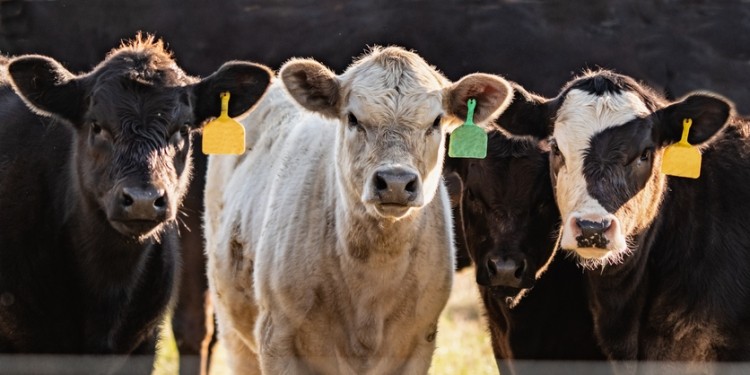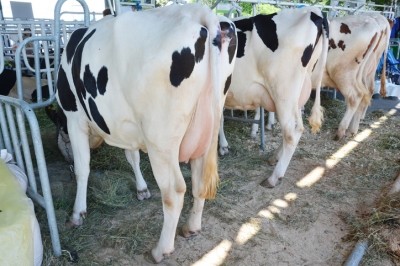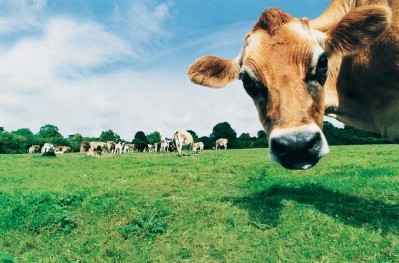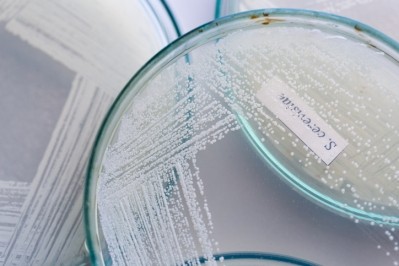Blended feed additives may provide antibiotic alternative for growing cattle

A team of researchers from institutions in Canada, China and Egypt explored the use of naturally sourced feed additives in the growing and finishing phases of cattle as alternatives for antibiotic use.
The group published the study in the journal, Animal Feed Science and Technology.
“The objectives of this study were to examine BL and BG as alternatives to in-feed antibiotics and to investigate their effects on growth performance, carcass traits, blood metabolites and antioxidant status of growing and finishing cattle,” the researchers said. Both feed additives BL (Bio-Lac Plus) and BG (Boviglo) contain lactic acid bacteria, lactobacillus fermentation products and enzymes.
The researchers found that cow receiving the IM, IMAT and IMBL diets had the highest final body weight, average daily gain (ADG), and gain to feed ratio. Diets that included BG boosted both ADG and the gain to feed ratio compared to results for control group animals.
The use of therapeutic antimicrobials was reduced for all cattle on supplemented diets, particularly those on the BL feed compared to the control, they said. However, during the finishing phase, feeding BL and BG diets did not alter growth performance or carcass elements.
“Supplementation of BL or BG improved ADG and feed efficiency during the stressful, early portion of the growing phase, but had no effect during finishing,” they added. “The results suggest that both BL and BG have the potential to be fed as alternatives to antimicrobial growth promoters in growing steers.”
The research project was funded by organizations including Alternatives to Beef Antimicrobials, Bio-Ag Consultants and Distributors Inc. and Natures Wave.
Why explore non-medicated feed additives?
In beef cattle production in North America it has been common practice to use hormonal anabolic implants and ionophore antibiotics, the researchers said. However, there is growing concern regarding the use of these types of growth promoters.
The European Union and other countries also have ended the use of hormones and antibiotics for growth promotion, they said. There has been a related interest in using feed additives including enzymes, probiotics and prebiotics during cattle production.
Past research has found that use of select probiotics can support growth performance and cattle health by limiting ruminal acidosis and other probiotics have been linked to the inhibition of some foodborne pathogens, they said.
There also has been a growing interest in using exogenous enzymes especially cellulases, proteases, hemicellulases and ferulic acid esterase, the researchers said. Previous research with dairy cows showed positive responses to the use of exogenous fibrolytic enzymes in diets – but use has been limited and results can vary.
Commercial mixes of exogenous enzymes and probiotics are starting to be available, they said. However, little is known about the influence of such feed additives on the growth performance or carcass qualities of beef cattle.
Two of the commercially available feed additive blends – Bio-Lac Plus (BL) and Boviglo (BG) – include lactic acid bacteria (LAB), lactobacillus fermentation products (LFPs) and enzymes, they said.
“We hypothesized that feeding BL to implanted cattle would have additive effects on growth performance, and that BG may act as an alternative to the current use of implants and in-feed antibiotics in beef cattle,” the researchers said. “We also hypothesized that feeding of BL and BG may impact carcass traits, possibly by exogenous enzymes increasing fiber digestion which could alter fat deposition.”
Feeding trial details
In the feeding trials, 75 steers were given one of five diets for a period of 112 days, the researchers said. Following the grower phase, all cows were transitioned to a finishing diet for an additional 112 days.
The diets included a control, the control plus a medicated implant (IM), control with an implant and antibiotics (IMAT), that diet with an implant and BL at 30g/steer/day (IMBL), the control diet and the control diet with supplemental BG at 5ml/steer/day (BG), they said. The basal diet was designed to support growth of 1.2kg/d during the growing phase.
“IMBL was designed to determine the additional benefit of adding BL, but BG was designed to assess whether BG can be fed as an alternative to implant or implant plus antibiotics,” they said. BL was added into the total mixed ration, and BG was diluted and sprayed onto the ration.
“When the growing phase finished, steers were maintained on the same treatments during the finishing phase, but were not re-implanted,” the researchers said. “Steers were adapted to the final finishing diets that consisted of 100 g/kg corn silage, 870 g/kg dry-rolled barley grain, and 30 g/kg protein, vitamin and mineral supplement over a 4-wk period by gradually replacing corn silage with dry-rolled barley grain.”
Feed provided and refused was noted daily, and intake was calculated, they said. Samples of diets and refusals were taken weekly for analysis.
Steer was weighed at the start and end of each phase and every 28 days, they said. In the growing stage, cows also were checked on day 14.
Dry matter intake, average daily gain, feed efficiency and net energy for maintenance (NEm) were calculated for each cow, they said.
Fecal and blood samples were gathered from a selection of steer on days 56 and 112 of the finishing phase for analysis, the researchers said.
At the end of the feeding trial, all cattle were harvested and carcass characteristics were recorded including hot carcass weight (HCW), dressing percentage, back fat thickness (BFT) marbling score, quality grade, longissimus muscle (LM), salable meat yield and abscessed livers, they said.
Results
During the growing phase of the trial, cows on the IM, IMBL and BG diet tended to have higher DMI than those on the control diet, the researchers said. Steer receiving the IM, IMAT and IMBL diets had improved ADG and the highest body weights, followed by BG with the control group being the lightest.
“Compared to IM, it is noteworthy that IMBL steers tended to exhibit greater ADG and improved feed efficiency during the first 28 d of the growing phase. Furthermore, no IMBL steers required treatment with antimicrobials as compared to the IM and control steers,” they said. “These results suggest that supplementation with BL may have potential growth and health benefits for steers during the early feeding period where stress is often highest.”
Steer on the BG diet had higher ADG than control group cows, they said. All four supplemented groups had improved gain to feed ratios compared to the control.
The number of cows needing additional treatment for bovine respiratory diseases was lower for cows on the supplemented diets compared to the control group, they said.
“In the finishing phase, the initial BW was greater for steers receiving IM and IMBL than for control and BG steers which was due to the treatment effects in the growing phase,” the researchers said. “However, final BW did not differ among treatments, and no treatment effects on DMI, ADG and G:F were observed.”
Cows on the IMAT diet tended to have higher NEm than those on the other diets, they added.
Carcass qualities including dressing percentage, BFT, LM, HCW, saleable meat yield and proportion of total abscessed livers were not altered by diets, although marbling score tended to be highest for steer on the IM diets, they said. Cows on the IMAT diet had a lower meat quality grade than those on other diets.
Blood urea nitrogen and NEFA levels were similar among diet, however, blood glucose was highest for BG steer and blood antioxidant and CAT was highest for IMAT steer, they said. Fecal IgA levels were higher for control and BG steer and fecal pH and total E.coli levels were similar for cows on all diets.
Source: Animal Feed Science and Technology
Title: Use of naturally sourced feed additives (lactobacillus fermentation products and enzymes) in growing and finishing steers: Effects on performance, carcass characteristics and blood metabolites
Authors: T. Ran, W. Gomaa, Y. Shen, A. Saleem, W. Yang and T. McAllister
DOI: doi.org/10.1016/j.anifeedsci.2019.05.013















